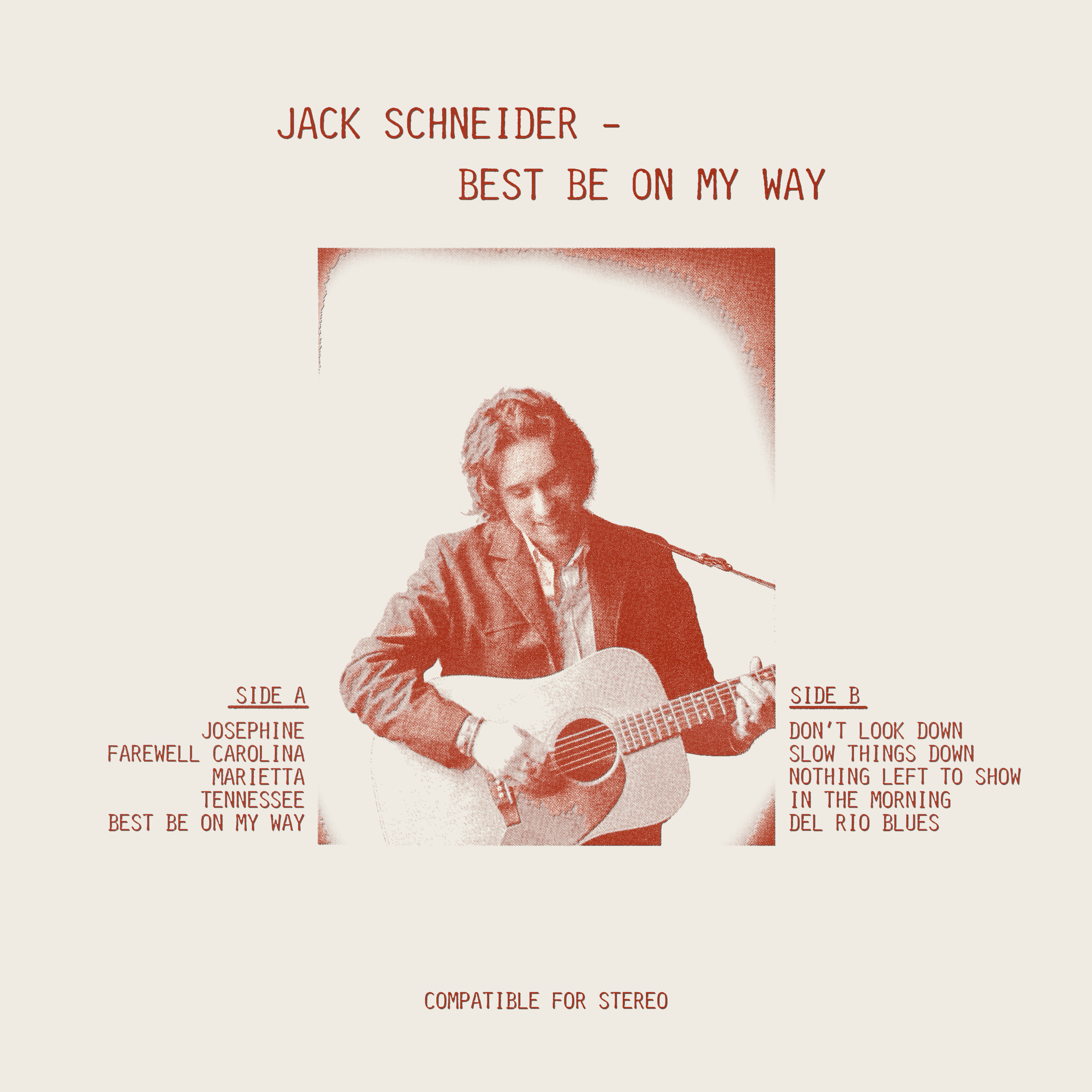
In a studio with no windows, with phones tucked away in instrument cases and playback running off of a tape machine, there are certain alternative ways of telling time: through the marked reels of tape piled up by the console, the sweat accumulated on the backs of shirts, the dwindling joviality of an assistant engineer. In spite of a few reluctant anachronisms, the recording of Jack Schneider’s debut album, Best Be On My Way, was a scene plucked straight from 1972. Recorded live to tape in Nashville with some of the city’s biggest names, Schneider’s inaugural record is a testament to tradition, timelessness, and the modern relevance of old ways.
The world of Jack Schneider is one strewn with eccentricity and nostalgia, where a New York cowboy wanders the streets of East Nashville donning a Stetson Range, a purist philosophy, and his beloved 1956 Martin D-28 guitar, Big Jim. He is, as some would say, a Nashville triple threat—guitarist, songwriter, and singer, in addition to producer, guitar collector, and tape machine enthusiast. Born in New York and raised in Georgia, Schneider picked up the guitar at three years old and began making trips to Nashville when he was in high school. There he sought out the legendary Gruhn Guitars, hoping to quench his insatiable thirst for knowledge of fretted instruments. Despite attending university in New York City, Schneider spent most school breaks and long weekends in Music City, working summers at Gruhn’s; it was there that he met and befriended Vince Gill, among other musical heroes. With one foot in New York and one in Nashville, Jack expanded his network as a session player and an artist in both cities, gracing the stages of The Bitter End and The Bluebird Cafe with equal character and charm.
Upon graduating from NYU’s Clive Davis Institute of Recorded Music in 2019, Schneider added rapidly to his laundry list of accomplishments: touring with Vince Gill as both guitar tech and rhythm guitar player; producing records for multiple up-and-coming Nashville artists (recorded to tape, of course); releasing his first singles to critical acclaim; and playing the Grand Ole Opry. Throughout the long months of quarantine, Schneider began working intensively with former Gruhn Guitars colleague and frequent collaborator, Wes Langlois. Shut up in the studio together for weeks, the two wrote, recorded, and released what they referred to as “vanishing albums:” full-length records accessible for a week at a time each during the pandemic, after which they were removed from streaming services and unavailable for physical purchase. It was from these ephemeral collections of songs that the seed for Schneider’s (permanent) debut record was born.
Best Be On My Way was recorded on a hot day in June at Nashville’s Sound Emporium. Inside the air conditioned studio there was a slight quiver in the air—the hum of a tape machine, the impression that the atmosphere was churning inside a black-and-white photograph. There was an unspoken sense, among those who knew Schneider well, of momentousness: the session itself felt as though it were a real-life culmination of a long and tenuous journey on Schneider’s part, in which he had collected friends and strangers along the way and gathered them together for the odyssey’s retelling. From childhood friends to recent mentors, the motley crew of musicians sat in a wide circle in the live room as around a campfire, much to the contemporarily trained engineers’ dismay. The players themselves were evidence of a gap Schneider is bridging between musical generations: Grammy-award winning artists Vince Gill and David Rawlings played alongside both Stuart Duncan and Dennis Crouch—longtime Nashville session musicians—and Liv Greene and Griffin Photoglou, two twenty-something artists fresh out of college.
Like the characters involved in the record’s making, the songs themselves trace a thread between past and present, connecting what was with what is and what will be with a lyrical hopefulness that doesn’t exclude honesty or fail to acknowledge hardship. From wistful odes to long lost loves to buoyant tales of moving on, Best Be On My Way is a record filled with hellos, goodbyes, and everything in between. “Through the sun and through the rain, I’ll take the pleasure with the pain,” comes the pronouncement on the title track, a song with an air of radical acceptance fitting for a debut LP. While songs like “Farewell, Carolina” and “Nothing Left To Show” nod to country western roots with lush harmonies from Vince Gill, others adhere to a folk-inspired ethos of emotional complexity and narrative simplicity. “In the Morning,” a sparse yet angelic duet between Schneider on guitar and Stuart Duncan on fiddle, is vaguely reminiscent of an old Irish ballad, telling the story of a bereaved lover who goes to sleep at night only to dream of reuniting with his lost beloved. Similarly, “Don’t Look Down” is somewhat of a tribute to Schneider’s folk-centric background, a rambling tune performed solo with childhood friend and Americana artist Liv Greene on banjo and harmonies.
The final moment of the record stands as evidence that, while respecting longstanding musical traditions, Schneider is not to be bound by convention: “Del Rio Blues” boasts both an electric guitar solo from David Rawlings (of Gillian Welch) and a mellow drum beat. With that spark of electricity, the end of the ultimate number fades out gradually, as if alluding to a yet unseen horizon. As a whole, the record is a testament to the necessity of looking at the past in order to know just where you’re headed. Riddled with raw truths, compelling stories, and unforgettable sonic motifs, Best Be On My Way is necessary listening for life’s long road ahead.